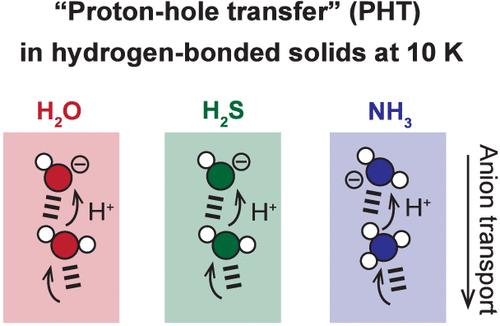当前位置:
X-MOL 学术
›
J. Phys. Chem. Lett.
›
论文详情
Our official English website, www.x-mol.net, welcomes your
feedback! (Note: you will need to create a separate account there.)
Signature of Proton–Hole Transfer in Hydrogen-Bonded Solids at 10 K
The Journal of Physical Chemistry Letters ( IF 4.8 ) Pub Date : 2024-11-15 , DOI: 10.1021/acs.jpclett.4c02812 Kensei Kitajima, Yoichi Nakai, Masashi Tsuge, Naoki Watanabe
The Journal of Physical Chemistry Letters ( IF 4.8 ) Pub Date : 2024-11-15 , DOI: 10.1021/acs.jpclett.4c02812 Kensei Kitajima, Yoichi Nakai, Masashi Tsuge, Naoki Watanabe

|
Although proton transport in water ice is well understood, proton–hole transfer (PHT) involving proton abstraction by anions remains less explored. This study investigates PHT in H2S and NH3 solids at low temperatures, aiming to determine whether these solids exhibit negative charge transport similar to that in ice. In H2S and NH3 solids at 10 K, surface HS– and NH2– anions in hydrogen-bonded systems trigger negative current flow, providing a clear signature of PHT. This negative current is controlled by electron flow and 193 nm ultraviolet irradiation, which generates HS– and NH2– anions on the solid surfaces. In bilayer H2S/H2O and NH3/H2O solids, a significant negative current is observed only in the NH3/H2O solid, which is attributed to the exothermic proton abstraction by NH2– from H2O at the bilayer interface, a process not available for H2S on ice. This study is the first to demonstrate PHT-induced electrochemical behavior in hydrogen-bonded solids other than ice.
中文翻译:

10 K 氢键固体中质子-空穴转移的特征
尽管水冰中的质子传输已广为人知,但涉及阴离子提取质子的质子-空穴转移 (PHT) 仍未得到充分探索。本研究调查了低温下 H2S 和 NH3 固体中的 PHT,旨在确定这些固体是否表现出类似于冰中的负电荷传输。在 10 K 的 H2S 和 NH3 固体中,氢键系统中的表面 HS- 和 NH2- 阴离子会触发负电流,提供 PHT 的明显特征。该负电流由电子流和 193 nm 紫外线照射控制,从而在固体表面产生 HS– 和 NH2– 阴离子。在双层 H2S/H2O 和 NH3/H2O 固体中,仅在 NH3/H2O 固体中观察到显着的负电流,这归因于 NH2– 在双层界面处从 H2O 中抽出放热质子,这一过程不适用于冰上的 H2S。这项研究首次证明了 PHT 在除冰以外的氢键固体中诱导的电化学行为。
更新日期:2024-11-15
中文翻译:

10 K 氢键固体中质子-空穴转移的特征
尽管水冰中的质子传输已广为人知,但涉及阴离子提取质子的质子-空穴转移 (PHT) 仍未得到充分探索。本研究调查了低温下 H2S 和 NH3 固体中的 PHT,旨在确定这些固体是否表现出类似于冰中的负电荷传输。在 10 K 的 H2S 和 NH3 固体中,氢键系统中的表面 HS- 和 NH2- 阴离子会触发负电流,提供 PHT 的明显特征。该负电流由电子流和 193 nm 紫外线照射控制,从而在固体表面产生 HS– 和 NH2– 阴离子。在双层 H2S/H2O 和 NH3/H2O 固体中,仅在 NH3/H2O 固体中观察到显着的负电流,这归因于 NH2– 在双层界面处从 H2O 中抽出放热质子,这一过程不适用于冰上的 H2S。这项研究首次证明了 PHT 在除冰以外的氢键固体中诱导的电化学行为。


















































 京公网安备 11010802027423号
京公网安备 11010802027423号